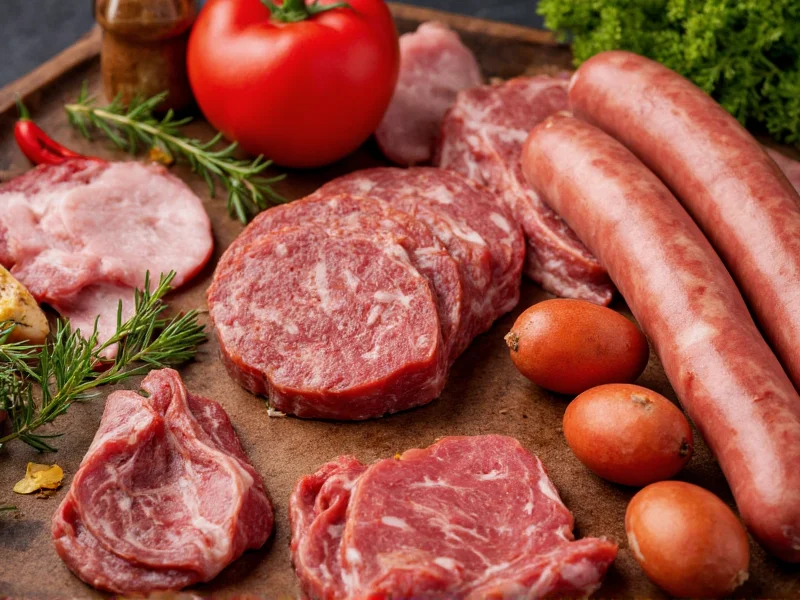Understanding the relationship between meats and sausages requires examining both the raw ingredients and the transformation process. Sausages serve as one of humanity's oldest food preservation techniques, dating back to ancient Mesopotamia around 3000 BCE. This ingenious method allowed communities to utilize entire animal carcasses efficiently while preventing waste.
Meat Selection for Sausage Production
The quality of sausages begins with careful meat selection. Most traditional sausages combine specific ratios of lean meat to fat—typically 70% lean to 30% fat—which creates optimal texture and moisture retention during cooking. Different animal proteins yield distinctive results:
| Meat Type | Fat Content | Flavor Profile | Common Sausage Applications |
|---|---|---|---|
| Pork | 25-30% | Rich, versatile | Bratwurst, Italian sausage, breakfast links |
| Beef | 15-20% | Bold, robust | Salami, chorizo, corned beef |
| Poultry | 7-10% | Mild, delicate | Chicken apple sausage, turkey breakfast patties |
| Lamb | 20-25% | Earthy, distinctive | Merguez, gyro meat, specialty sausages |
Global Sausage Varieties and Preparation Methods
Traditional sausage making techniques vary significantly across cultures, reflecting local ingredients and preservation needs. European traditions dominate many popular varieties, but distinctive preparations exist worldwide. Understanding different types of sausages worldwide reveals fascinating culinary adaptations to regional conditions.
European sausages typically fall into four categories: fresh (requiring immediate cooking), cooked (pre-cooked and ready to eat), dry-cured (preserved through salt and drying), and smoked (preserved through smoke exposure). German bratwurst represents a classic fresh sausage, while Spanish chorizo exemplifies dry-cured preparation. Italian salami bridges both cured and smoked techniques.
Asian sausage traditions often incorporate unique flavor profiles. Chinese lap cheong uses rice wine and soy sauce in its preparation, while Filipino longganisa features distinctive vinegar-based marinades. These traditional sausage making techniques demonstrate remarkable regional diversity while maintaining the fundamental principle of meat preservation.
Nutritional Considerations of Meats and Sausages
The nutritional value of processed meats varies considerably based on ingredients and preparation methods. While providing high-quality protein and essential nutrients like iron and B vitamins, certain sausages contain elevated sodium and fat levels. Understanding the nutritional value of processed meats helps consumers make informed choices.
Fresh sausages typically contain 250-300 calories per 3-ounce serving, with 20-25 grams of protein. Cured varieties often contain higher sodium levels—sometimes exceeding 500mg per serving—as salt serves as both flavor enhancer and preservative. When evaluating different sausage options, consumers should consider both macronutrient composition and processing methods.
Food Safety Practices for Meat Products
Safe handling of raw meats remains critical throughout the sausage production chain. The USDA recommends maintaining meat temperatures below 40°F (4°C) during storage and handling. Ground meats, including sausage mixtures, require thorough cooking to 160°F (71°C) internal temperature to eliminate potential pathogens.
Home sausage makers should follow strict hygiene protocols: sanitize all equipment before and after use, keep meat mixtures chilled during preparation, and use high-quality casings to prevent contamination. Properly identifying high quality sausages involves checking for consistent color, appropriate firmness, and absence of off-odors.
Storage Guidelines for Fresh Meats and Sausages
Understanding proper storage guidelines for fresh meats prevents spoilage and foodborne illness. Fresh sausages maintain quality for 1-2 days in the refrigerator, while cooked sausages last 3-4 days. For extended preservation, freezing remains the most effective method—properly wrapped sausages maintain quality for 1-2 months in standard freezer conditions.
Vacuum-sealed sausages demonstrate significantly longer shelf life, with frozen products remaining safe for consumption up to 3 months. When thawing frozen sausages, the refrigerator method (24 hours for every 5 pounds) proves safest, preventing bacterial growth that occurs during room-temperature thawing.
Cooking Techniques for Various Sausages
Different sausages require specific cooking approaches to achieve optimal results. Fresh sausages benefit from gentle cooking methods like poaching followed by searing, which ensures thorough cooking without casing rupture. Pre-cooked varieties like kielbasa require only heating through, while dry-cured sausages often serve as ingredients rather than standalone items.
Mastering appropriate cooking methods for various sausages enhances both safety and flavor development. The water-boiling method works well for fresh sausages, while cast-iron skillet preparation creates desirable caramelization on pre-cooked varieties. Always use a meat thermometer to verify internal temperatures, as visual cues alone prove unreliable for determining doneness.











 浙公网安备
33010002000092号
浙公网安备
33010002000092号 浙B2-20120091-4
浙B2-20120091-4